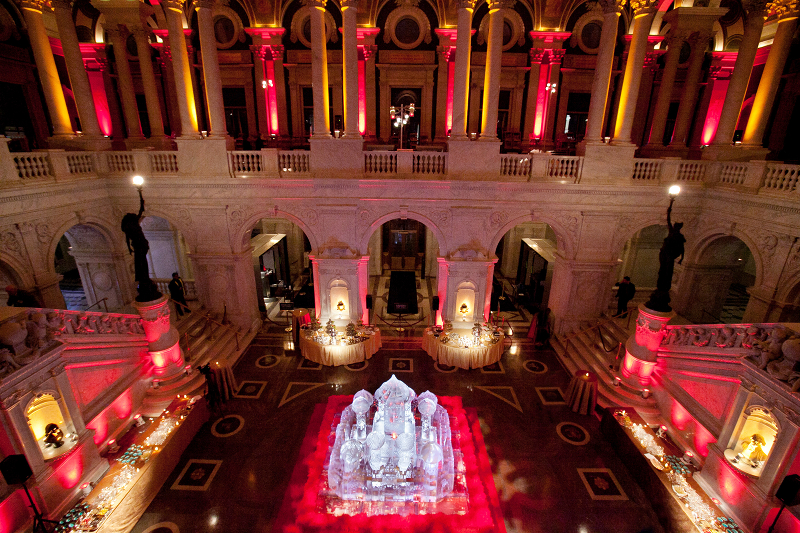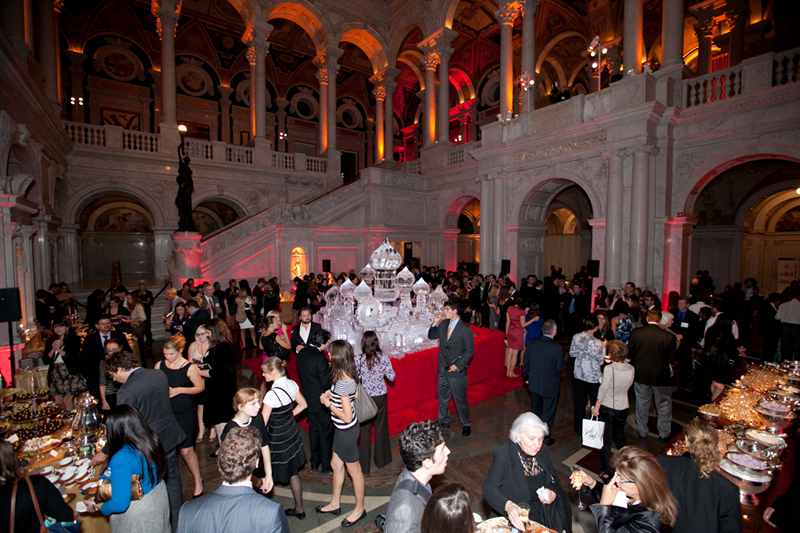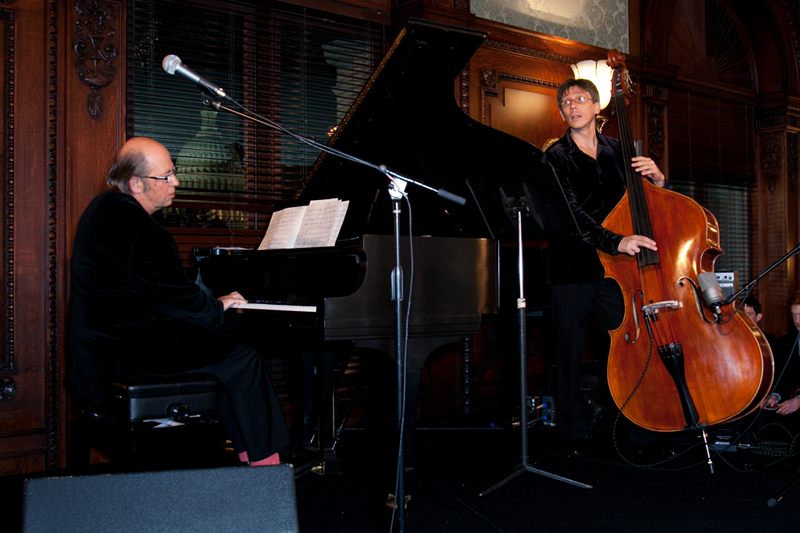Beyond the occasional “in Soviet Russia” wisecrack, would you expect American college students to have any interest in the present-day relations of the two Cold War adversaries?
At American University, the answer is: absolutely yes!
This enthusiasm was on display at the Library of Congress' Jefferson Building at the end of September, at a grand fête launching the Initiative for Russian Culture in American University's College of Arts and Sciences. Inside the elaborate, neo-Baroque monument to the written word, more than 500 guests, including nearly 200 American students from schools as far away as Pennsylvania, dined on Russian specialties and mingled to the sweet background strains of jazz played by Russian musicians.
Interest in improving relations in the post-Cold War era between the United States and Russia took on a new urgency after the icy level reached in 2008. The Initiative for Russian Culture was borne out of a desire to address the stereotypes that poison the positions Russians and Americans take with each other, permeating the cultural exchanges so vital to rebuilding relations after the four decades of suspicion and hostility. American University is cooperating with the Russian Embassy in Washington, DC, to present a range of film showings, art exhibits, and musical performances open to the community.
As Honorary Co-Chair of the Initiative for Russian Culture Advisory committee, Russian Federation Ambassador Sergey I. Kislyak explained what the Initiative meant for him when he explained, “I have always been thinking about how I can make available for normal people, for students, for those who will be governing this country and my country in the future... more chances to learn about life in each other's countries; to learn about what we are, and as I always underline – to learn what we are not – that is very important.”
The launch party was just the beginning of that effort. After guests were treated to Russian cuisine and imported beverages just steps away from the display of Thomas Jefferson's books, they were ushered downstairs, plied with popcorn and Russian chocolates, and treated to the first showing in the Initiative's lineup of award-winning Russian films. The season's theme explores the popularity of the distinctively American style of music - jazz - among Russians under the Soviet Union, and as such, the night's film showing was We are Jazzmen, which follows a young musician in his efforts to start a jazz band after his expulsion from school because of his love for the “bourgeois” form of music.
But the evening was far from over once the movie ended. Guests spilled out of the auditorium, only to find the hall of the Jefferson Building had been transformed: red lights accented the architecture and created a warm, intimate environment to chase away the fall chill. Russian desserts, from Apple Charlottes to Trubochki with marzipan cream, covered two tables, with eight different flavors of ice cream and Russian black tea offered just steps away. Near the majestic Reading Room, tradition met history as guests sipped coffee next to the Gutenberg Bible.
In the Members Room, a live jazz performance by the world-famous Igor Bril on piano and Evgeny Onishchenko on the double bass filled all the chairs, even though guests seemed to filter in and out throughout the performance. The true center of attention was the majestic, six-foot-tall and twenty-five-foot square ice sculpture of an Orthodox Cathedral, with each iconic onion dome decorated in near-perfect imitation of the real structure.
Susan E. Lehrman, Washington's de-facto cultural ambassador, the Chair of the Initiative for Russian Culture's Advisory Committee, and sponsor of the night's event, floated among the guests. Never without a group of admirers surrounding her, she was a standout vision in white - just as she stands out in any crowd of dignitaries or students alike - meeting different cultures and transporting her guests to another world in everything she touches.
At the end of the evening, to emerge from the glowing red cocoon of music and merriness into the chilly fall Washington reality was a jolt. If the Initiative for Russian Culture can continue the magic of their launching throughout the coming years, there is no doubt they will impact a new generation of thinkers on the state of the American-Russian relationship.
For more information on the program, and for a schedule of upcoming film showings, visit the Initiative on Russian Culture.



Top of Page Photo: Students from American University.
Photo 1: A view of the decor from above.
Photo 2: The post-movie crowd.
Photo 3: Famous jazz pianist Igor Bril, bass player Eugene Onishchenko.
Photos courtesy of American University's Initiative for Russian Culture.


a global affairs media network
When Cultures Combine at the Library of Congress

October 10, 2011
Beyond the occasional “in Soviet Russia” wisecrack, would you expect American college students to have any interest in the present-day relations of the two Cold War adversaries?
At American University, the answer is: absolutely yes!
This enthusiasm was on display at the Library of Congress' Jefferson Building at the end of September, at a grand fête launching the Initiative for Russian Culture in American University's College of Arts and Sciences. Inside the elaborate, neo-Baroque monument to the written word, more than 500 guests, including nearly 200 American students from schools as far away as Pennsylvania, dined on Russian specialties and mingled to the sweet background strains of jazz played by Russian musicians.
Interest in improving relations in the post-Cold War era between the United States and Russia took on a new urgency after the icy level reached in 2008. The Initiative for Russian Culture was borne out of a desire to address the stereotypes that poison the positions Russians and Americans take with each other, permeating the cultural exchanges so vital to rebuilding relations after the four decades of suspicion and hostility. American University is cooperating with the Russian Embassy in Washington, DC, to present a range of film showings, art exhibits, and musical performances open to the community.
As Honorary Co-Chair of the Initiative for Russian Culture Advisory committee, Russian Federation Ambassador Sergey I. Kislyak explained what the Initiative meant for him when he explained, “I have always been thinking about how I can make available for normal people, for students, for those who will be governing this country and my country in the future... more chances to learn about life in each other's countries; to learn about what we are, and as I always underline – to learn what we are not – that is very important.”
The launch party was just the beginning of that effort. After guests were treated to Russian cuisine and imported beverages just steps away from the display of Thomas Jefferson's books, they were ushered downstairs, plied with popcorn and Russian chocolates, and treated to the first showing in the Initiative's lineup of award-winning Russian films. The season's theme explores the popularity of the distinctively American style of music - jazz - among Russians under the Soviet Union, and as such, the night's film showing was We are Jazzmen, which follows a young musician in his efforts to start a jazz band after his expulsion from school because of his love for the “bourgeois” form of music.
But the evening was far from over once the movie ended. Guests spilled out of the auditorium, only to find the hall of the Jefferson Building had been transformed: red lights accented the architecture and created a warm, intimate environment to chase away the fall chill. Russian desserts, from Apple Charlottes to Trubochki with marzipan cream, covered two tables, with eight different flavors of ice cream and Russian black tea offered just steps away. Near the majestic Reading Room, tradition met history as guests sipped coffee next to the Gutenberg Bible.
In the Members Room, a live jazz performance by the world-famous Igor Bril on piano and Evgeny Onishchenko on the double bass filled all the chairs, even though guests seemed to filter in and out throughout the performance. The true center of attention was the majestic, six-foot-tall and twenty-five-foot square ice sculpture of an Orthodox Cathedral, with each iconic onion dome decorated in near-perfect imitation of the real structure.
Susan E. Lehrman, Washington's de-facto cultural ambassador, the Chair of the Initiative for Russian Culture's Advisory Committee, and sponsor of the night's event, floated among the guests. Never without a group of admirers surrounding her, she was a standout vision in white - just as she stands out in any crowd of dignitaries or students alike - meeting different cultures and transporting her guests to another world in everything she touches.
At the end of the evening, to emerge from the glowing red cocoon of music and merriness into the chilly fall Washington reality was a jolt. If the Initiative for Russian Culture can continue the magic of their launching throughout the coming years, there is no doubt they will impact a new generation of thinkers on the state of the American-Russian relationship.
For more information on the program, and for a schedule of upcoming film showings, visit the Initiative on Russian Culture.



Top of Page Photo: Students from American University.
Photo 1: A view of the decor from above.
Photo 2: The post-movie crowd.
Photo 3: Famous jazz pianist Igor Bril, bass player Eugene Onishchenko.
Photos courtesy of American University's Initiative for Russian Culture.


